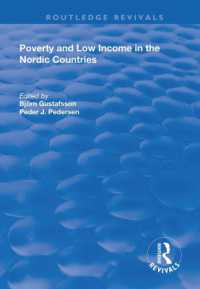- ホーム
- > 洋書
- > 英文書
- > Science / Mathematics
Full Description
The Conference on Boundary Elements and Mesh Reduction Methods (BEM/MRM) is recognised as the international forum for the latest advances in these techniques and their applications in science and engineering. Launched in 1978 the Conference continues to attract original contributions and has become the forum for their rapid dissemination throughout the international scientific community. Practically all new boundary element ideas have first appeared in the proceedings of these meetings.
Contents
Contents Section 1: Acoustic problems The pFFT accelerated BEM for the simulation of 3-D acoustic problems; Numerical investigation on three treatments for eliminating the singularities of acoustic fundamental solutions in the singular boundary method; FEM/wideband FMBEM coupling to model fluid-structure interaction; 3D acoustic wave simulation using BEM formulations and the ACA algorithm; Boundary element approaches for acoustic computation of perforated silencers Section 2: Advanced meshless methods Mesh reduction strategy: special element for modelling anisotropic materials with defects; Quadratically consistent integration schemes for the element-free Galerkin method; Chebyshev tau meshless method based on the highest derivative for solving a class of two-dimensional parabolic problems; Dynamic analysis of the stabilized meshfree method for the Mindlin-Reissner plate; The variational multiscale element free Galerkin method for the simulation of power-law fluid flows; Numerical comparison of two boundary meshless methods for water wave problems Section 3: Boundary knot method Mixed boundary node method for free vibration analysis of rectangular plates with variable thickness and general boundary conditions; Automatic hybrid mesh generation for the boundary face method Section 4: Dual boundary element techniques Numerical evaluation of high-order singular boundary integrals using third-degree B-spline basis functions; Multiple reciprocity boundary face method for transient heat conduction in functionally graded materials; Integral equation formulations in 2D inhomogeneous magnetoelectroelastic media; Three detecting indexes and five regularization techniques for degenerate scales in the BEM/BIEM Section 5: Fracture and crack propagation Static and dynamic fracture analysis in thin piezoelectric laminas by the boundary element method; A time domain BEM for transient dynamic straight crack in piezoelectric solids Section 6: Fundamental solution method Recent advances in singular boundary method for ultra-thin structural problems; Dynamic Green's functions of a buried point load with applications to drainage; The method of fundamental solutions for three-dimensional scattering of elastic waves in layered half space Section 7: Heat transfer A time-domain precise BEM for solving transient heat conduction problems with variable heat conductivities; The application of a multi-domain boundary face method in a steady state heat conduction problem Section 8: Hybrid methods The PCGM for Cauchy inverse problems in 3D potential; M2L optimization in FMBEM and its GPU implementation; The influence of packing dimension on the effective thermal properties of doubly-periodic composites by using super hybrid finite body elements Section 9: Integration techniques A direct method for evaluating arbitrary high-order singular curved boundary integrals; Adaptive integration technique for nearly singular integrals in near-field acoustics boundary element analysis; Analytical integrations of the linearly interpolated triangular IBEM element with the aid of Matlab Symbolic Math Toolbox; Thermal stress analysis of functionally graded material structures using analytical expressions in radial integration BEM; Application of exponential transformation coupled with adaptive subdivision technique for nearly singular boundary integrals in elasticity problems Section 10: Multipole BEM Acoustic eigenvalue analysis using a fast boundary element approach and a contour integral method; Solution of stress intensity factors for 2-D multiple crack problems by the fast multipole boundary element method; A SVD accelerated kernel-independent fast multipole method and its application to BEM; Regularization fast multipole boundary element method for potential flow problems in 3D vortex method Section 11: Structural problems Treatment for geometry noise in mesh generation for welded tubular Y-joints in the BFM; Influence of strut structure on hemodynamic characteristics by the boundary elementary method Section 12: Transient response methods ACA-accelerated time domain BEM for 3-D elastodynamics; An automatic simulation tool for thermal analysis of gravity dams by BFM; A comparative study of time domain BEM for 3D elastodynamic analysis; Numerical study of multiple bubble dynamics with the BEM-ACA approach Section 13: Advanced numerical solvers A general algorithm for numerical evaluation of nearly singular integrals over high-order geometry elements in 3D BEM; A geometric cross approximation method








